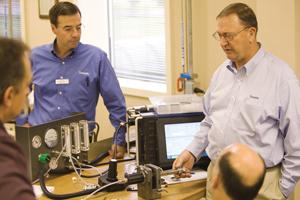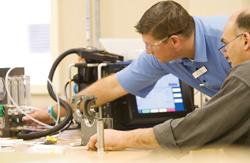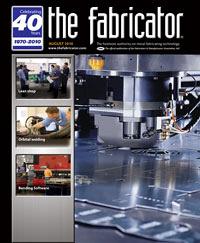Manager, Welding System Products
- FMA
- The Fabricator
- FABTECH
- Canadian Metalworking
Categories
- Additive Manufacturing
- Aluminum Welding
- Arc Welding
- Assembly and Joining
- Automation and Robotics
- Bending and Forming
- Consumables
- Cutting and Weld Prep
- Electric Vehicles
- En Español
- Finishing
- Hydroforming
- Laser Cutting
- Laser Welding
- Machining
- Manufacturing Software
- Materials Handling
- Metals/Materials
- Oxyfuel Cutting
- Plasma Cutting
- Power Tools
- Punching and Other Holemaking
- Roll Forming
- Safety
- Sawing
- Shearing
- Shop Management
- Testing and Measuring
- Tube and Pipe Fabrication
- Tube and Pipe Production
- Waterjet Cutting
Industry Directory
Webcasts
Podcasts
FAB 40
Advertise
Subscribe
Account Login
Search
Automatic orbital welding simplified
Recent developments reduce the guesswork
- By John Glessman
- August 4, 2010
- Article
- Arc Welding

: Figure 1: Newer automatic orbital welding systems provide operators with many preset programs and enhanced user interfaces to assist with programming.
Many different industries use automatic orbital gas tungsten arc welding (GTAW) to help their products achieve maximum leak integrity, high performance, and ultracleanliness. The process is used in various applications, from the biopharmaceutical and semiconductor industries to petrochemical and power plants to chemical processing and refining operations.
Automatic orbital GTAW establishes an arc between a nonconsumable tungsten electrode (positioned in the weld head) and the base material that is being welded, creating a weld puddle. The electrode and weld puddle both are surrounded by a shielding gas, which is fed through the weld head to protect the electrode, molten weld puddle, and solidifying weld metal from atmospheric contamination. The heat produced by the arc melts the base material, and the electrode moves along the joint and progressively melts and joins the adjoining surfaces.
Small, portable inverter power supplies, advanced control systems, and other developments have made orbital GTAW systems practical for many applications. The advent of new technology has led to further improvements in the systems’ ease of use, weld consistency, and weld reliability.
Open Platform Design
Orbital welding power supplies have been incorporating more skills of the welder into the welding system itself, enabling efficiencies in automation, programming, and documentation. An open platform design allows an interface with standard devices and the ability to expand as technology evolves and needs change.
Automation. Aspects of the welding process that historically would be undertaken manually, such as travel speed, arc gap, current control, and gas flow, are controlled through electronic and mechanical means. This minimizes many of the variables in the welding process that can lead to errors or defects and enables welders to focus on overseeing the process and completing actual welds.
Programming. Every orbital weld, regardless of the application, requires the creation of a program that controls the output characteristics of the system. Systems can simplify programming by providing step-by-step procedures to create programs for many different tube diameters, wall thicknesses, and base materials (see Figure 1).
Rather than build programs manually using charts or tables, past weld parameter data, or memory, operators can create programs by selecting pertinent data from pick lists or drop-down menus. The system then creates the initial program for the operation, which reduces the chance for human error and decreases start-up time. This feature also is helpful for operators welding unfamiliar materials.
Newer orbital welding systems are available with integral USB ports that enable operators to plug in a keyboard, mouse, or number keypad for simplified data entry. Operators also can download welding programs via a USB flash drive or update operating system software to add features or functionality.
Documentation. In some industries, documentation of the weld is important for quality assurance and control. Traditionally, weld operators have had to maintain detailed, written weld logs that must be entered into databases and formatted into reports.
Today’s orbital welding technology enables this data to be stored within the system for retrieval and transfer to databases for analysis and reporting. Data management can help an organization track trends, review production rates, and calculate costs per weld.

: Figure 2: Automatic orbital welding is a highly controlled process to ensure welds are consistent and repeatable.
High-speed thermal printers built into newer orbital welders also help with documentation. For example, users can print a hard copy reference of weld parameter details. Based on procedural requirements, operators might need to “coupon in” by creating a schedule, completing a weld, examining it for quality, and documenting these actions by printing the coupon. At specified intervals, the operator will perform similar actions to “coupon out.” Coupon printouts provide a record of verification to meet quality control requirements.
Weld Repeatability, Consistency, and Efficiency
With orbital welding, the electrode is rotated in an orbit around a joint on a rotor. The rotor and electrode are housed in the weld head, which rotates around the tube. The process is highly controlled to help ensure that high-quality welds can be produced on a consistent and repeatable basis (see Figure 2).
Variables are maintained at preset levels. The system automatically starts and completes the weld, stepping from one variable setting to the next at specific locations along the joint or at predetermined times during the process.
Gas Control. Newer orbital power supply designs feature automatic shield gas control to the weld head (see Figure 3). This helps eliminate operator inefficiency or the possibility of incorrect settings that could negatively affect weld quality. The controller adjusts gas flow automatically based on the program selected for a particular weld. The integrated flow controller also prevents operators from initiating the weld without gas flow, an error that could result in damage to the weld head or the workpiece.
Blast Purge. Further gas control advancements enable operators to improve their efficiency when welding at locations where the power supply is a long distance from the weld head. A sufficient gas volume must be present at the weld location before the weld starts. Blast purge fills gas lines rapidly, then automatically returns gas flow to normal levels, allowing operators to start a weld sooner.
Power Considerations
Power supplies with high power outputs can weld larger-diameter and heavy-walled tube and pipe while maintaining consistent welds. Newer welding systems offer the power output needed to weld the heavy-walled components found in general industrial applications like oil and gas, as well as smaller-diameter, thin-walled tubing for R&D or semiconductor applications.
Initializing the welding process requires a high-frequency, high-voltage arc start, which could result in electromagnetic interference (EMI). EMI is an electrical disturbance that can interfere with devices such as computers and other sensitive electronics. Excessive EMI in a welding project could cause computers to shut down and work to be lost. Welding systems with low-EMI arc start technology allow the arc start to occur without affecting the operation of equipment in proximity.
Portability and Accessibility
Small, lightweight orbital welding systems are designed for portability. Weld system power supplies can be moved easily from one job site to another. Remote controls and detachable weld heads and fixtures allow joints to be pre-positioned and enable welding in hard-to-reach places. There only needs to be enough clearance at the weld site to allow the weld head to make a full 360-degree orbit around the tubing.
As the world becomes a smaller place, a single welding system may be used across cultures and geographies. Welding systems with multiple language capabilities built into the interface let operators switch among languages at the touch of a button. Some welding systems also have universal voltage input that adjusts automatically to a country’s voltage input.
New advancements are helping orbital welding deliver repeatable, consistent, quality welds and making the process cost-effective and viable for plant managers and welding operators.
About the Author
John Glessman
31500 Aurora Road
Solon, OH 44138
440-349-5934
Related Companies
subscribe now

The Fabricator is North America's leading magazine for the metal forming and fabricating industry. The magazine delivers the news, technical articles, and case histories that enable fabricators to do their jobs more efficiently. The Fabricator has served the industry since 1970.
start your free subscription- Stay connected from anywhere

Easily access valuable industry resources now with full access to the digital edition of The Fabricator.

Easily access valuable industry resources now with full access to the digital edition of The Welder.

Easily access valuable industry resources now with full access to the digital edition of The Tube and Pipe Journal.
- Podcasting
- Podcast:
- The Fabricator Podcast
- Published:
- 04/16/2024
- Running Time:
- 63:29
In this episode of The Fabricator Podcast, Caleb Chamberlain, co-founder and CEO of OSH Cut, discusses his company’s...
- Trending Articles
AI, machine learning, and the future of metal fabrication

Employee ownership: The best way to ensure engagement

Steel industry reacts to Nucor’s new weekly published HRC price

How to set a press brake backgauge manually

Capturing, recording equipment inspection data for FMEA

- Industry Events
16th Annual Safety Conference
- April 30 - May 1, 2024
- Elgin,
Pipe and Tube Conference
- May 21 - 22, 2024
- Omaha, NE
World-Class Roll Forming Workshop
- June 5 - 6, 2024
- Louisville, KY
Advanced Laser Application Workshop
- June 25 - 27, 2024
- Novi, MI



























